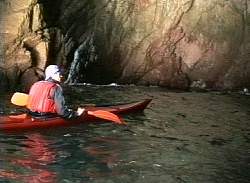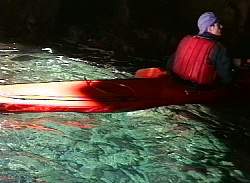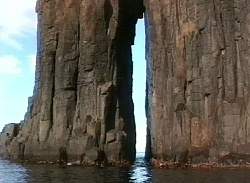 | In August 1997 we managed to get into Deep Glen Bay Cave once again. The eastern entrance is quite narrow and partly blocked by rocks just under the surface. |
 | Once inside the cave opens out and then takes a 90� turn to the north. Because of this second entrance the cave interior is illuminated to some depth. I was particularly pleased that we had timed our arrival just as the sun was streaming into the cave, |
 | The sun reflects off the cave walls. The clear waters become an irridescent turquoise. This entrance has a small waterfall that veils the cave mouth with a curtain of sparkling droplets. Jamie and Phillip, newcomers to sea kayaing, were entranced by the cave. |
 | On our previous trip there was no way we could get into this cave. The swells were so large that they occupied the whole height of the cave. Today there was barely any swell at all. |
 | We circled through the cave quite a few times marvelling at the incredible lighting in the cave. The light from the eastern entrance can be seen just to the right of Phillips' head. |
 | It was quite hard to get video of the spectacle in the cave. The lighting was so bright it tended to reduce the picture to a contrasty, colourless scene. This picture gives some idea of the brilliant colours and clearness of the water. |
 | The bright sunlight reflected off the myriads of splashes raining down on us as we exited the cave. To the right of this picture there is a narrow channel leading back to the eastern cave entrance. The rock infront is a tall, island pinnacle. |
 | The cave is at the base of a huge cliff, probably 300-400' high. Deposits of limestone are gradually being deposited over the cave entrance, brought down by the constant stream of water running down the cliff. |
 | On the northern entrance a small rainbow was produced by the strong sunlight refracting through the millions of water droplets cascading from a cushion of dark green moss. |
 | Later on that afternoon we entered many other sea caves that we had previously not been in. the rocks here are basalt and tend to form tall, narrow caves due to the columnar jointing common in this type of rock. |
 | Jamie and Phillip both agreed that just getting into these spectacular caves made sea kayking worthwhile. We took ages meandering in and out of all the nooks and crannies we could find. The sea isn't always this kind. |












